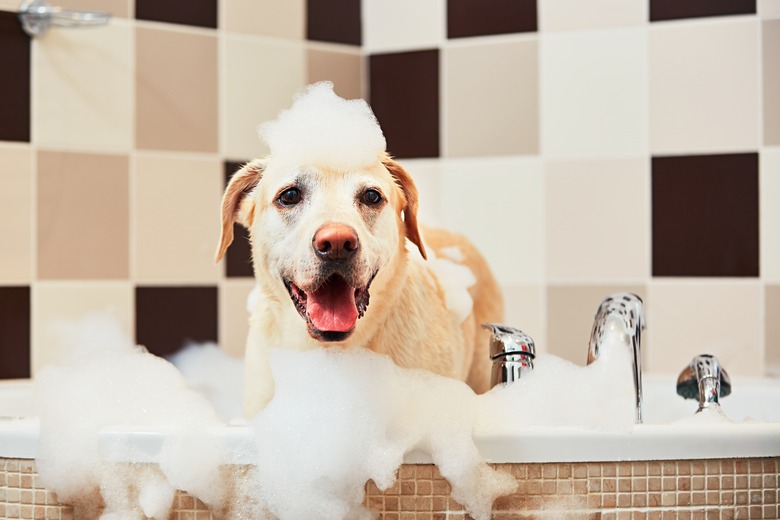How To Bathe Dogs With Castor Oil & Olive Oil
Fact: Dogs love to get dirty. From rolling in questionable substances at the park to frolicking in deep mud puddles, every pup needs a good scrub now and then. And for those dogs that suffer from allergies or dry, irritated skin, a bath and shampoo using certain oils could be the solution. Some causes of skin discomfort range from flea or insect bites to environmental agitators like dust, pollen, or mold. But don't overdo the soap and water. Too much bathing of some breeds can strip the oil from dogs' skin.
A few skin problems can sometimes be fixed with a change in diet. In fact, a little olive oil can be given to improve the moisture and shine in a canine coat. And olive oil and castor oil for dogs can also be used externally when you're giving your pup a bath. Vegetable or mineral oil are especially ideal for removing sticky goo like wax, paint, or tree sap (dab it on before you wash to loosen the substance).
A word of caution, however, regarding essential oils. These concentrated liquids are commonly found in household products for cleaning and potpourri that freshens the air — but they can be poisonous to dogs. If you suspect your dog has come into contact with essential oils, particularly peppermint, citrus, cinnamon, and ylang-ylang, take your dog to an emergency vet immediately.
For some bathing tips as well as how to apply cooking oils and castor oil for dogs, read on.
1. Line up your supplies
Find a tub that can hold your dog comfortably and then arrange your bathing gear so it's close at hand (you don't want to leave your pup unattended lest he escapes while sopping wet!). You'll need your dog's brush, olive or castor oil, dog shampoo, a large plastic pitcher, and a couple of fluffy towels. You may also want to have a soft washcloth to clean certain areas.
2. Brush before bathing
Before you get your pet wet, give him a thorough brushing to remove extra hair and loosen mats or knots (make sure to brush away any visible dirt or mud too). This is also a good time to check for signs of fleas or ticks. Ticks leave a circular scab, which should heal with time. If your dog has been scratching a lot, cooler water may soothe his skin. Fill the tub with a couple of inches of warm water and then use the pitcher to wet your dog.
3. Massage with care
Gently rub a small amount of castor oil for dogs into your animal's coat. You can also try coconut oil, which can ease skin maladies such as bites, stings, dryness, or itching. Allow the castor oil or coconut oil you've applied to sink in for a bit and then wash it out with the dog shampoo. Work gently from your pup's head to his tail, adding more water as needed and being careful not to get his eyes, nose, and ears too wet. If your dog sports wrinkles in his skin the way pugs and Shar-Peis do, use the washcloth to carefully clean these skin folds. Rinse your pet's fur thoroughly and then rub him dry with the towels.
4. Add fragrant essential oils
While essential oils are dangerous when ingested by dogs, they can be used to scent your pet's shampoo. Try adding a couple of drops of coconut oil or herbal oils such as peppermint or lemon to your dog's formula. You can also add fragrant essential oils to dishwashing soap, another shampoo alternative to try when bathing your dog.
References
- American Kennel Club: How Often Should You Bathe Your Dog? Groomers Weigh In
- Innovative Veterinary Care: The Benefits of Virgin Olive Oil for Dogs
- ASPCA: My Pet Walked Through Paint—Now What? How to Decontaminate Your Pet
- ASPCA: Dog Grooming Tips
- AKC: Coconut Oil for Dogs: Is It Really Good For Them?
- VCA Hospitals: Essential Oil and Liquid Potpourri Poisoning in Dogs


